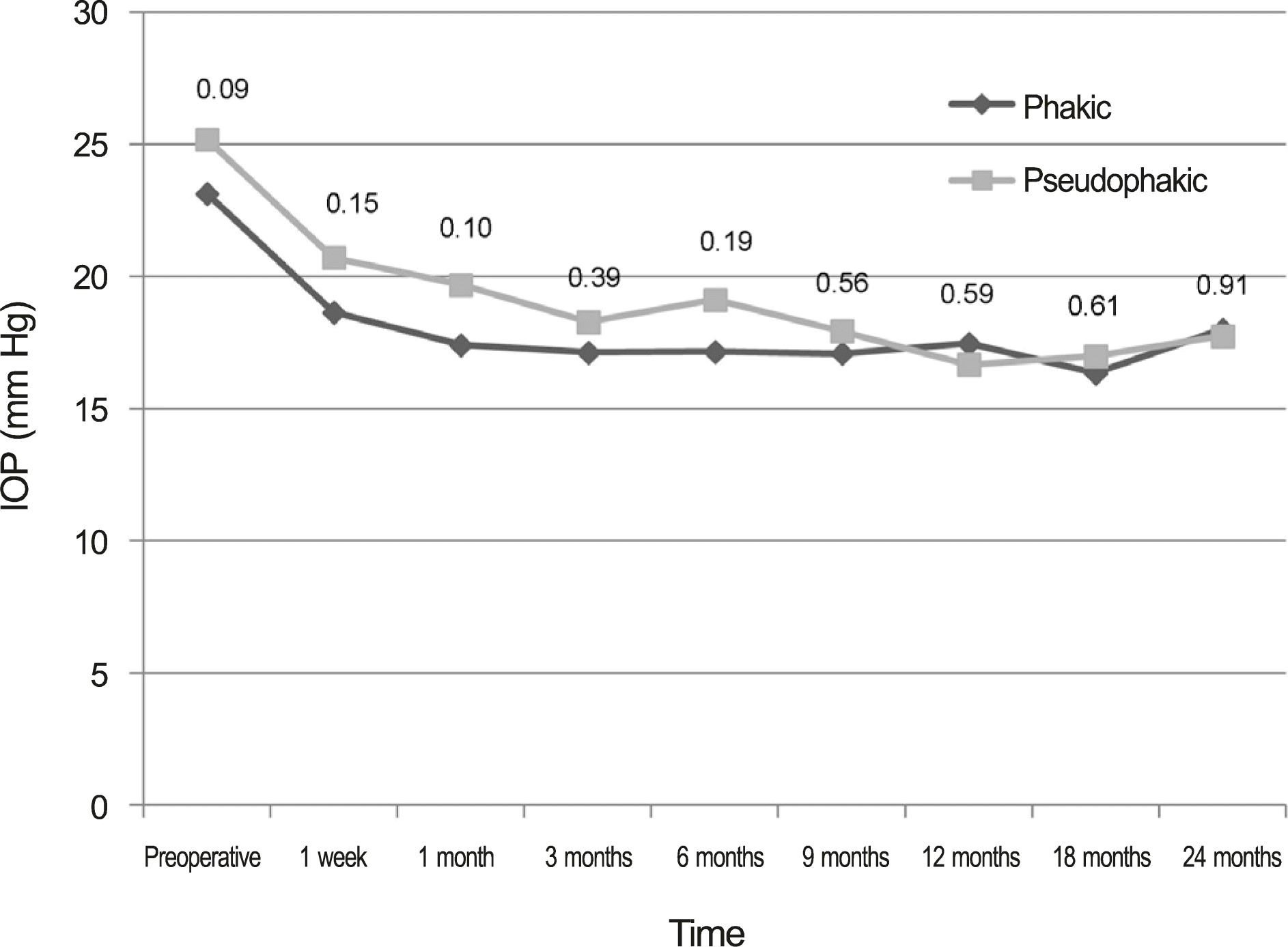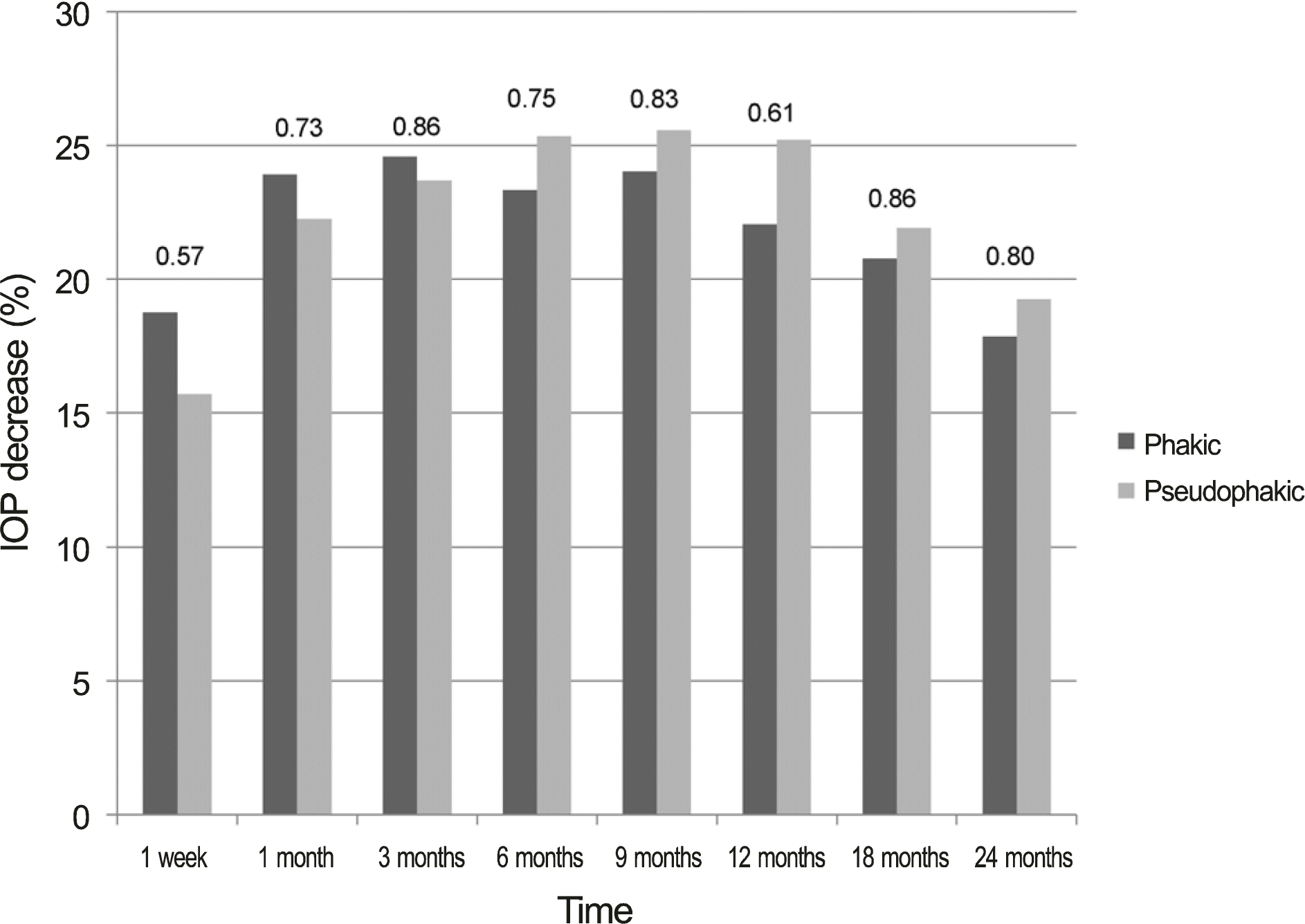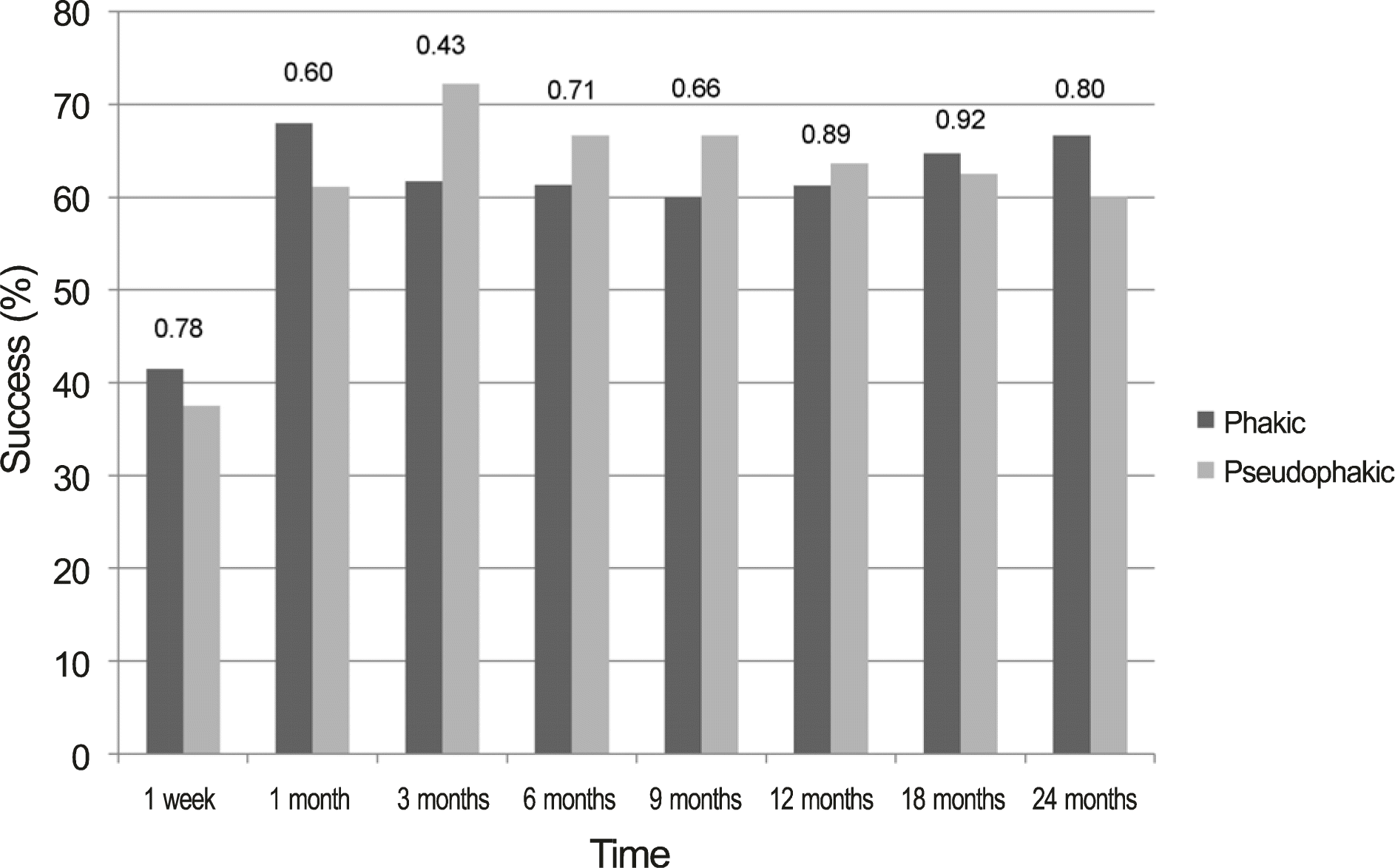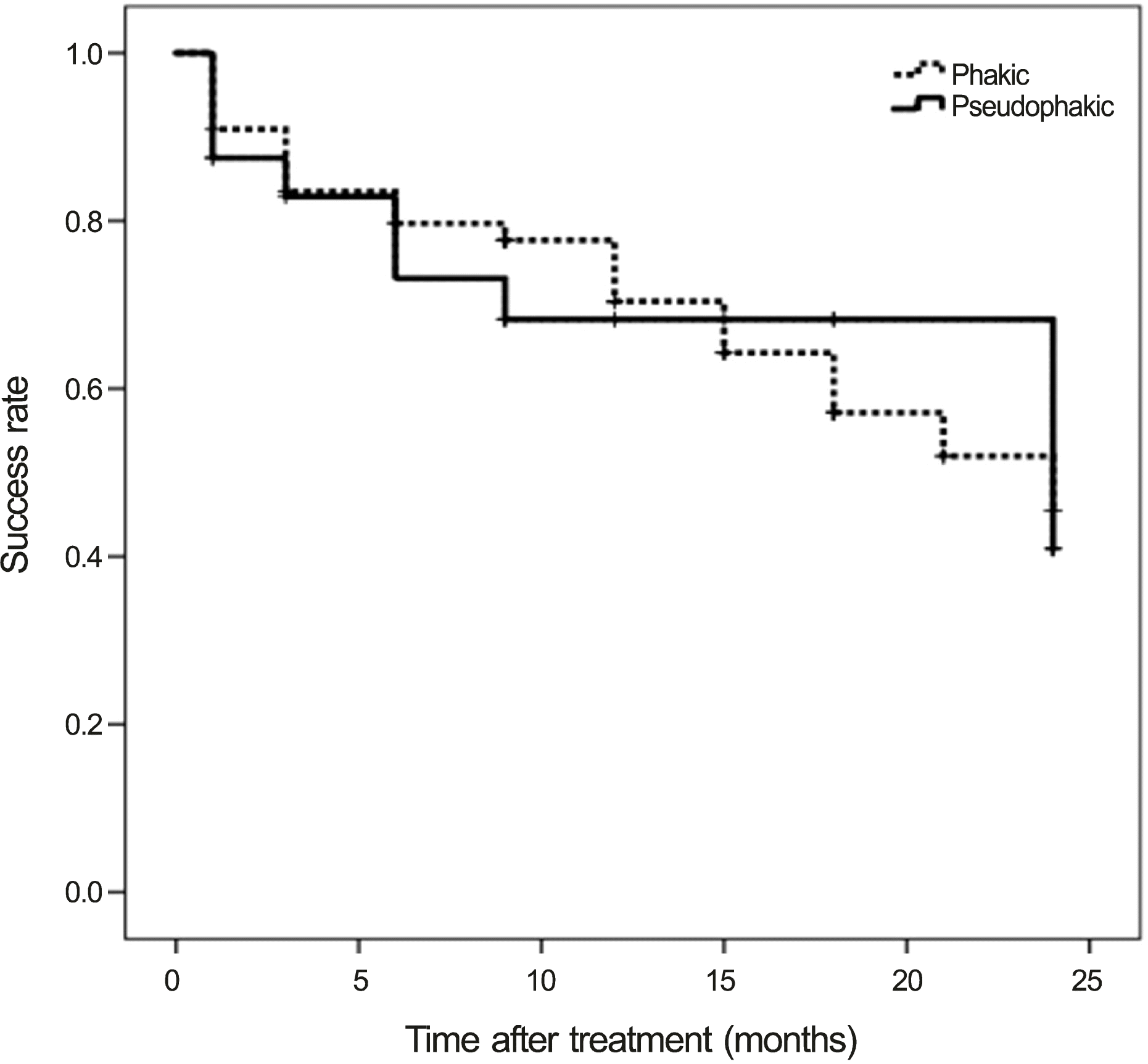Abstract
Purpose
To compare the efficacy of selective laser trabeculoplasty (SLT) in phakic and pseudophakic eyes in primary open-an-gle glaucoma.
Methods
Charts of 55 phakic eyes and 24 pseudophakic eyes that underwent 360-degree SLT were retrospectively reviewed. Intraocular pressure (IOP) was measured before SLT and 1 week, 1, 3, 6, 9, 12, 18 and 24 months after SLT. Treatment success was defined as IOP reduction ≥ 20% without additional medications, laser or glaucoma surgery. Mean IOP change, mean percentage of IOP reduction and success rates of phakic and pseudophakic eyes were compared.
Results
Mean percentage of IOP reduction after SLT at 1 week and 1, 3, 6, 9, 12, 18, and 24 months were 18.8%, 23.9%, 24.6%, 23.3%, 24.0%, 22.1%, 20.8%, and 17.9%, respectively, in the phakic group and 15.7%, 22.3%, 23.7%, 25.3%, 25.6%, 25.2%, 21.9%, and 19.3%, respectively, in the pseudophakic group. Success rates were 57.6 ± 11.9% in the phakic group and 61.3 ± 10.4% in the pseudophakic group. No statistically significant differences in IOP change, percentage of IOP reduction, and success rates were observed between the groups at each time point after SLT (p > 0.05).
Go to : 
References
1. Latina MA, Park C. Selective targeting of trabecular meshwork cells: in vitro studies of pulsed and CW laser interactions. Exp Eye Res. 1995; 60:359–71.

2. Latina MA, Tumbocon JA. Selective laser trabeculoplasty: a new treatment option for open angle glaucoma. Curr Opin Ophthalmol. 2002; 13:94–6.

3. Latina MA, Gulati V. Selective laser trabeculoplasty: stimulating the meshwork to mend its ways. Int Ophthalmol Clin. 2004; 44:93–103.

4. Latina MA, Sibayan SA, Shin DH, et al. Q-switched 532-nm Nd:YAG laser trabeculoplasty (selective laser trabeculoplasty): a multicenter, pilot, clinical study. Ophthalmology. 1998; 105:2082–8. discussion 2089-90.
5. Juzych MS, Chopra V, Banitt MR, et al. Comparison of long-term outcomes of selective laser trabeculoplasty versus argon laser trabeculoplasty in open-angle glaucoma. Ophthalmology. 2004; 111:1853–9.

6. Damji KF, Shah KC, Rock WJ, et al. Selective laser trabeculoplasty v argon laser trabeculoplasty: a prospective randomised clinical trial. Br J Ophthalmol. 1999; 83:718–22.

7. Saccà S, Marletta A, Pascotto A, et al. Daily tonometric curves after cataract surgery. Br J Ophthalmol. 2001; 85:24–9.
8. Issa SA, Pacheco J, Mahmood U, et al. A novel index for predicting intraocular pressure reduction following cataract surgery. Br J Ophthalmol. 2005; 89:543–6.

9. Pohjalainen T, Vesti E, Uusitalo RJ, Laatikainen L. Phacoemulsification and intraocular lens implantation in eyes with open-angle glaucoma. Acta Ophthalmol Scand. 2001; 79:313–6.

10. Shrivastava A, Singh K. The effect of cataract extraction on intraocular pressure. Curr Opin Ophthalmol. 2010; 21:118–22.

11. Shazly TA, Latina MA, Dagianis JJ, Chitturi S. Effect of prior cataract surgery on the long-term outcome of selective laser trabeculoplasty. Clin Ophthalmol. 2011; 5:377–80.

12. Werner M, Smith MF, Doyle JW. Selective laser trabeculoplasty in phakic and pseudophakic eyes. Ophthalmic Surg Lasers Imaging. 2007; 38:182–8.

13. Seymenoğlu G, Baser EF. Efficacy of selective laser trabeculoplasty in phakic and pseudophakic eyes. J Glaucoma. 2015; 24:105–10.

14. Lai JS, Chua JK, Tham CC, Lam DS. Five-year follow up of selective laser trabeculoplasty in Chinese eyes. Clin Experiment Ophthalmol. 2004; 32:368–72.

15. Martow E, Hutnik CM, Mao A. SLT and adjunctive medical therapy: a prediction rule analysis. J Glaucoma. 2011; 20:266–70.
16. Hodge WG, Damji KF, Rock W, et al. Baseline IOP predicts selective laser trabeculoplasty success at 1 year post-treatment: results from a randomised clinical trial. Br J Ophthalmol. 2005; 89:1157–60.

17. McIlraith I, Strasfeld M, Colev G, Hutnik CM. Selective laser trabeculoplasty as initial and adjunctive treatment for open-angle glaucoma. J Glaucoma. 2006; 15:124–30.

Go to : 
 | Figure 1.Mean IOP after selective laser trabeculoplasty for phakic and pseudophakic eyes. The numbers on graph indicates p-value at each time point. IOP = indicates intraocular pressure. |
 | Figure 2.Mean percentage decrease in IOP from baseline for pseudophakic and phakic eyes. The numbers on graph indicates p-value at each time point. IOP = indicates intraocular pressure. |
 | Figure 3.Success rate (≥ 20% intraocular pressure decrease) for phakic and pseudophakic eyes. The numbers on graph indicates p-value at each time point. |
 | Figure 4.In the Kaplan-Meier chart for phakic and pseudophakic eyes using the definition of success, the course of the curves was dispersed. There were not statistically significant differences between the survival curves in the follow-up period (log-rank test, p=0.933). |
Table 1.
Patient demographics at baseline
| Characteristics | Phakic | Pseudophakic | p-value |
|---|---|---|---|
| Age (year) | 65.0 ± 12.2 | 66.9 ± 11.6 | 0.52* |
| Female | 22 (40.0) | 7 (29.2) | 0.51† |
| Right eye | 30 (54.5) | 11 (45.8) | 0.64† |
| No. of medications | |||
| 1 | 6 (10.9) | 2 (8.3) | 0.72† |
| 2 | 15 (27.3) | 4 (16.7) | 0.40† |
| 3 | 21 (39.8) | 9 (37.5) | 0.91† |
| 4 | 15 (27.3) | 11 (45.8) | 0.11† |
| Type of medications | |||
| Prostaglandin analogue | 53 (96.4) | 23 (95.8) | 0.99† |
| β-blocker | 28 (50.9) | 17 (70.8) | 0.10† |
| Carbonic anhydrase inhibitor | 49 (89.1) | 20 (83.3) | 0.48† |
| α-2 adrenergic agonist | 23 (51.1) | 13 (54.2) | 0.81† |
Table 2.
Change from baseline intraocular pressure (mm Hg) after selective laser trabeculoplasty
| Time | Phakic | Pseudophakic | p-value* |
|---|---|---|---|
| 1 week | 4.42 ± 5.59 | 4.62 ± 5.07 | 0.88 |
| 1 month | 5.78 ± 4.77 | 4.40 ± 5.55 | 0.30 |
| 3 months | 5.85 ± 4.52 | 6.32 ± 6.33 | 0.74 |
| 6 months | 5.49 ± 5.32 | 5.69 ± 8.07 | 0.91 |
| 9 months | 5.57 ± 6.25 | 7.00 ± 6.86 | 0.48 |
| 12 months | 4.75 ± 4.70 | 7.00 ± 5.72 | 0.19 |
| 18 months | 4.41 ± 3.12 | 5.00 ± 4.08 | 0.70 |
| 24 months | 3.56 ± 4.36 | 4.75 ± 7.50 | 0.72 |




 PDF
PDF ePub
ePub Citation
Citation Print
Print


 XML Download
XML Download